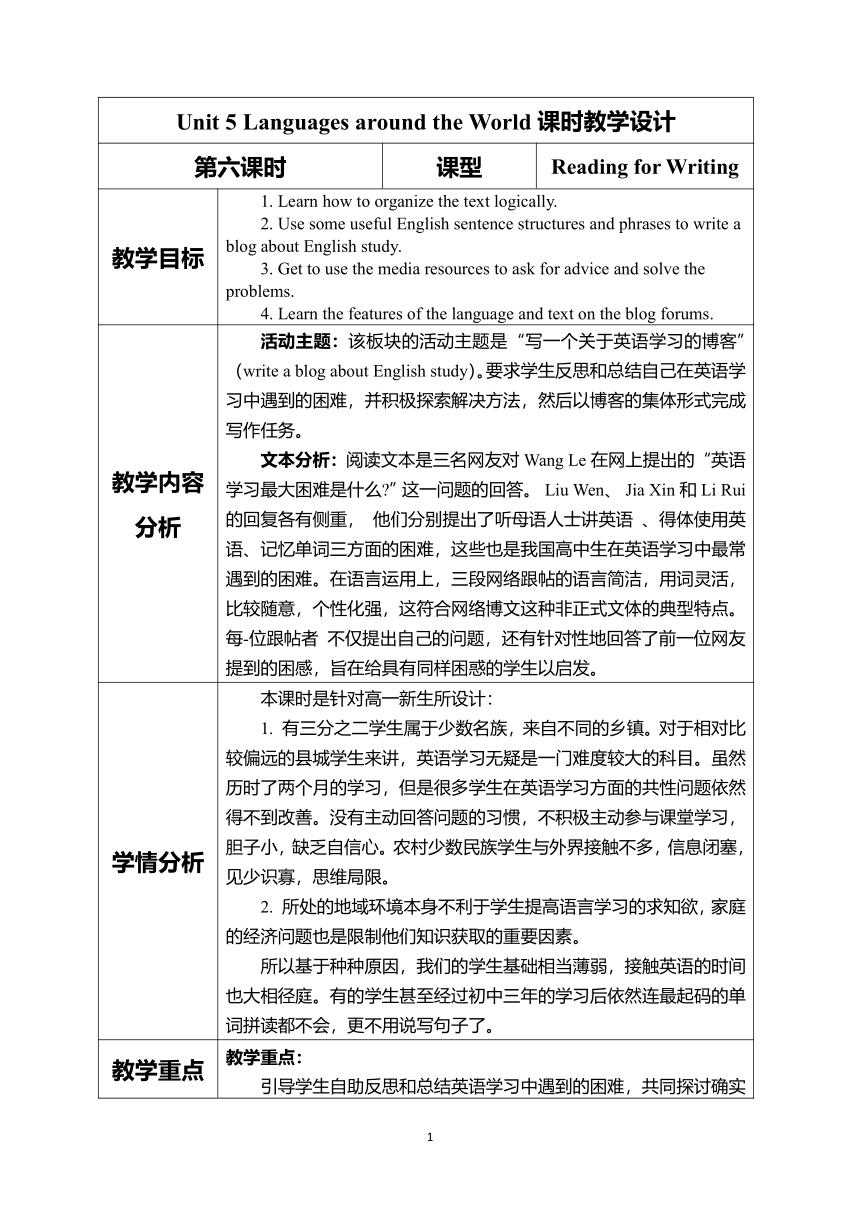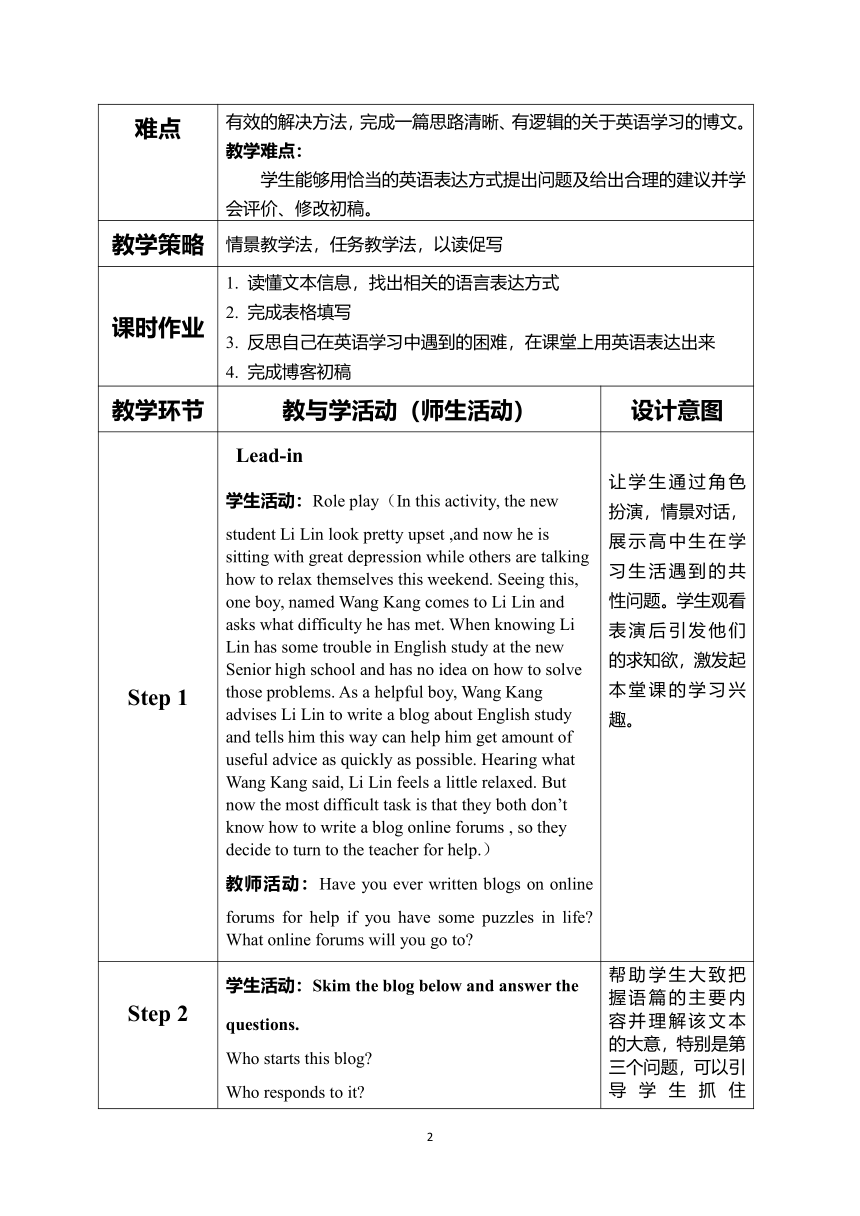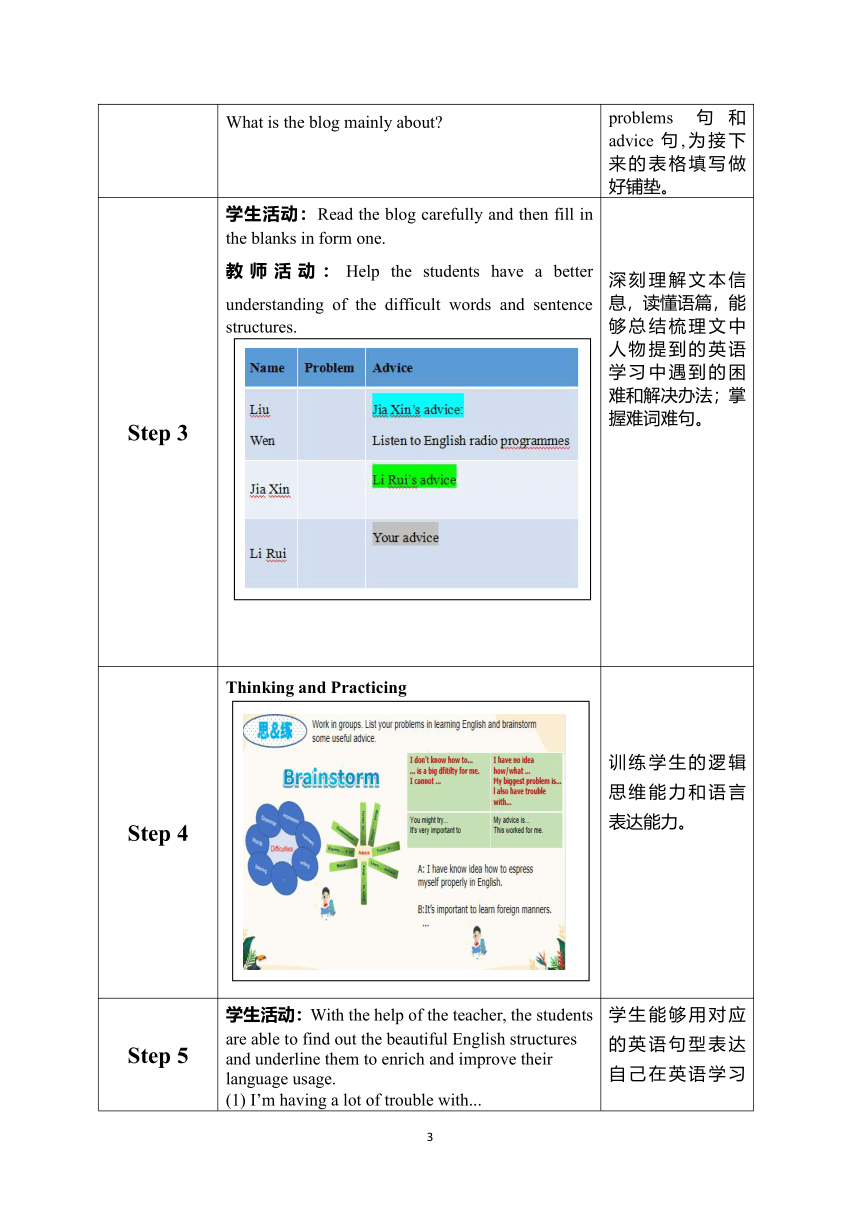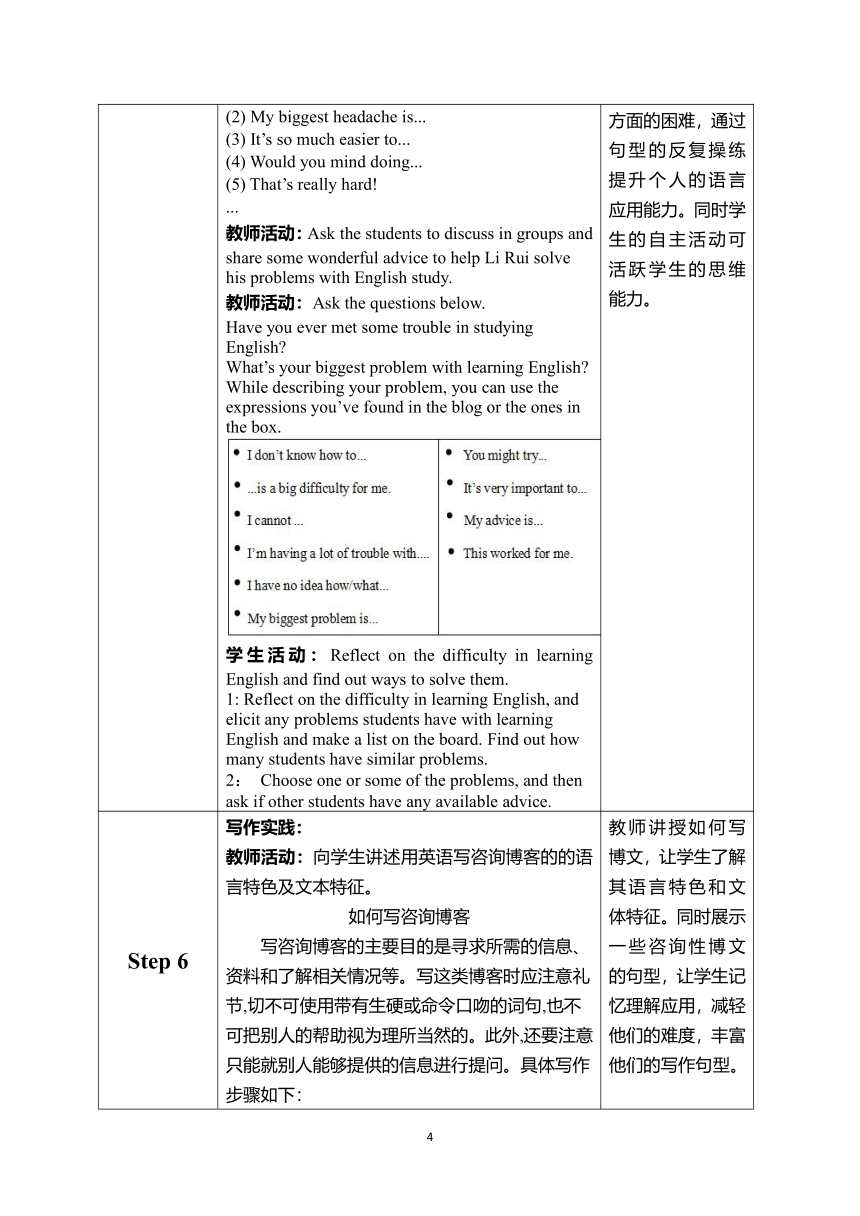Unit 5 Languages around the World Reading for Writing 课时教学设计
文档属性
| 名称 | Unit 5 Languages around the World Reading for Writing 课时教学设计 |

|
|
| 格式 | doc | ||
| 文件大小 | 501.1KB | ||
| 资源类型 | 试卷 | ||
| 版本资源 | 人教版(2019) | ||
| 科目 | 英语 | ||
| 更新时间 | 2021-11-26 18:18:57 | ||
图片预览




文档简介
Unit 5 Languages around the World课时教学设计
第六课时 课型 Reading for Writing
教学目标 1. Learn how to organize the text logically.2. Use some useful English sentence structures and phrases to write a blog about English study.3. Get to use the media resources to ask for advice and solve the problems.4. Learn the features of the language and text on the blog forums.
教学内容分析 活动主题:该板块的活动主题是“写一个关于英语学习的博客”(write a blog about English study)。要求学生反思和总结自己在英语学习中遇到的困难,并积极探索解决方法,然后以博客的集体形式完成写作任务。文本分析:阅读文本是三名网友对Wang Le在网上提出的“英语学习最大困难是什么 ”这一问题的回答。 Liu Wen、 Jia Xin和Li Rui的回复各有侧重, 他们分别提出了听母语人士讲英语 、得体使用英语、记忆单词三方面的困难,这些也是我国高中生在英语学习中最常遇到的困难。在语言运用上,三段网络跟帖的语言简洁,用词灵活,比较随意,个性化强,这符合网络博文这种非正式文体的典型特点。每-位跟帖者 不仅提出自己的问题,还有针对性地回答了前一位网友提到的困感,旨在给具有同样困惑的学生以启发。
学情分析 本课时是针对高一新生所设计:1. 有三分之二学生属于少数名族,来自不同的乡镇。对于相对比较偏远的县城学生来讲,英语学习无疑是一门难度较大的科目。虽然历时了两个月的学习,但是很多学生在英语学习方面的共性问题依然得不到改善。没有主动回答问题的习惯,不积极主动参与课堂学习,胆子小,缺乏自信心。农村少数民族学生与外界接触不多,信息闭塞,见少识寡,思维局限。2. 所处的地域环境本身不利于学生提高语言学习的求知欲,家庭的经济问题也是限制他们知识获取的重要因素。所以基于种种原因,我们的学生基础相当薄弱,接触英语的时间也大相径庭。有的学生甚至经过初中三年的学习后依然连最起码的单词拼读都不会,更不用说写句子了。
教学重点难点 教学重点:引导学生自助反思和总结英语学习中遇到的困难,共同探讨确实有效的解决方法,完成一篇思路清晰、有逻辑的关于英语学习的博文。教学难点: 学生能够用恰当的英语表达方式提出问题及给出合理的建议并学会评价、修改初稿。
教学策略 情景教学法,任务教学法,以读促写
课时作业 1. 读懂文本信息,找出相关的语言表达方式2. 完成表格填写3. 反思自己在英语学习中遇到的困难,在课堂上用英语表达出来4. 完成博客初稿
教学环节 教与学活动(师生活动) 设计意图
Step 1 Lead-in学生活动:Role play(In this activity, the new student Li Lin look pretty upset ,and now he is sitting with great depression while others are talking how to relax themselves this weekend. Seeing this, one boy, named Wang Kang comes to Li Lin and asks what difficulty he has met. When knowing Li Lin has some trouble in English study at the new Senior high school and has no idea on how to solve those problems. As a helpful boy, Wang Kang advises Li Lin to write a blog about English study and tells him this way can help him get amount of useful advice as quickly as possible. Hearing what Wang Kang said, Li Lin feels a little relaxed. But now the most difficult task is that they both don’t know how to write a blog online forums , so they decide to turn to the teacher for help.)教师活动:Have you ever written blogs on online forums for help if you have some puzzles in life What online forums will you go to 让学生通过角色扮演,情景对话,展示高中生在学习生活遇到的共性问题。学生观看表演后引发他们的求知欲,激发起本堂课的学习兴趣。
Step 2 学生活动:Skim the blog below and answer the questions.Who starts this blog Who responds to it What is the blog mainly about 帮助学生大致把握语篇的主要内容并理解该文本的大意,特别是第三个问题,可以引导学生抓住problems 句和advice句,为接下来的表格填写做好铺垫。
Step 3 学生活动:Read the blog carefully and then fill in the blanks in form one.教师活动:Help the students have a better understanding of the difficult words and sentence structures. 深刻理解文本信息,读懂语篇,能够总结梳理文中人物提到的英语学习中遇到的困难和解决办法;掌握难词难句。
Step 4 Thinking and Practicing 训练学生的逻辑思维能力和语言表达能力。
Step 5 学生活动:With the help of the teacher, the students are able to find out the beautiful English structures and underline them to enrich and improve their language usage.(1) I’m having a lot of trouble with...(2) My biggest headache is...(3) It’s so much easier to...(4) Would you mind doing...(5) That’s really hard!...教师活动:Ask the students to discuss in groups and share some wonderful advice to help Li Rui solve his problems with English study.教师活动:Ask the questions below.Have you ever met some trouble in studying English What’s your biggest problem with learning English While describing your problem, you can use the expressions you’ve found in the blog or the ones in the box.学生活动:Reflect on the difficulty in learning English and find out ways to solve them.1: Reflect on the difficulty in learning English, and elicit any problems students have with learning English and make a list on the board. Find out how many students have similar problems.2: Choose one or some of the problems, and then ask if other students have any available advice. 学生能够用对应的英语句型表达自己在英语学习方面的困难,通过句型的反复操练提升个人的语言应用能力。同时学生的自主活动可活跃学生的思维能力。
Step 6 写作实践:教师活动:向学生讲述用英语写咨询博客的的语言特色及文本特征。如何写咨询博客写咨询博客的主要目的是寻求所需的信息、资料和了解相关情况等。写这类博客时应注意礼节,切不可使用带有生硬或命令口吻的词句,也不可把别人的帮助视为理所当然的。此外,还要注意只能就别人能够提供的信息进行提问。具体写作步骤如下: 首段:开门见山,提出问题。直接提出自己所遇到的问题。 主体段落:询问具体问题。所提问题一定要具体、明确,不能含糊其辞,否则对方会不知如何回答。 结尾段:表明想要得到回答的迫切心情,对别人所能给予的任何帮助都要感谢。注意:(1)言辞恳切,态度诚恳。向别人征求意见,尤其是长辈或者不熟悉的人,态度要诚恳,语气要委婉。如:询问时可以使用“Could you please…”等疑问句。 (2)思路清晰,表述清楚。由于询问有可能给对方带来麻烦,所以语言应简洁、清晰、无歧义。层次分明,让人一看就能明白你的问题。(3)正确把握时态,确保语言准确。表述自己目前遇到的困难,因此应用一般现在时,而表述自己在得到帮助后可能会取得进步,用一般将来时。常用表达:1. 咨询问题:I would like to know whether you can provide me with information regarding…I would be most grateful if you could send me information regarding/concerning...I am writing to see if it is possible for you to provide me with information regarding…Besides, is there anything that I should pay special attention to Would you be so kind as to tell me… I wish to request information about…2. 交代自己所面临的问题:I have met some trouble in…I find it difficult to…I don't know how to…3. 请求对方给出建议:Would you like to…so that… Would you mind…?Would you be so kind to tell me…?Could you please..…?I would be forever grateful if you could send me information concerning.…展望自己获得建议后可能会取得的进步:I'm sure with your help I can make great progress.I think I will surely…with your advice.In the near future,I am sure I can..…4. 表明获取信息的急切心情:I am looking forward to your immediate response.Looking forward to your immediate response.Your attention to this letter would be highly appreciated.I am waiting for your quick reply.Thank you in advance for your cooperation/assistance. 教师讲授如何写博文,让学生了解其语言特色和文体特征。同时展示一些咨询性博文的句型,让学生记忆理解应用,减轻他们的难度,丰富他们的写作句型。
Step 7 学生活动:(1)学生在英语学习中可能会遇到很多困难,在写作时可选择一个自认为最棘手、最需要解决的问题。教师提醒学生对于问题的描述要具体清晰、解决问题的方法要具有针对性。(2)学生独立完成博文初稿。例文:I have trouble with phrasal verbs.There are so many of them and it seems impossible to work out the meanings just from the words. And some of the verbs have different meanings. For example, put off can mean postpone, discourage (someone from doing something),and make someone dislike (something). I try to use phrasal verbs sometimes, but I usually use the wrong one! My classmates had some suggestions for me. One was to use flash cards and to write down the phrasal verb on one side and a sentence using the phrasal verb on the other side. Then I can study them when I have time, like on the bus. Another suggestion was to use the phrasal verb in a sentence that is true for me, so that it's easy to remember. For example, I always put off doing my homework. I think my classmates gave me some good advice. Next time I hear a phrasal verb, I'll write it down and think of a sentence that uses the verb. Maybe I'll draw a picture too, to make it easier to remember.(3)学生利用活动中的评价清单,在小组成员间进行作文互评,相互提出修改建议。教师应引导学生重点关注一般性内容,让学生检查或反思对方的作品和自己的作品在清晰描述学习问题、明确提出改进建议和充分阐述主题等方面的情况。这些都是写作的高层次要求。课后学习:学生活动:(1)学生基于同伴的修改,在老师的帮助和建议下,对自己的博文进行修改,确定终稿。学生在小组内交流,然后推荐各自组内的优秀博文,由教师投影或由学生自己朗读出来。(2) 教师活动:课后教师可以选择谈论英语学习中遇到的典型问题及解决方法的博文,把它们做成墙报,以供全班同学浏览借鉴。这样一来,在英语学习中遇到困难时,有的同学可能会在墙报上找到相应的解决方法,同时也能有效地促进学生英语学习策略的形成。 要求学生限时完成博文初稿,初步检测本堂课学生学到的内容。学生间进行博文互评,教师展示一篇博文范文,让学生知道自己存在的问题,及时查缺补漏。
Homework 1. 课后复习巩固博文的写作特点。2. 及时复习课堂上学到的新单词和常见的写作句型。3. 尝试在博客上用英语写一篇关于其他方面的博文
Blackboard Design
课时 教学 设计 反思 在平时的作文写作训练中,要让学生养成按以下步骤进行写作的习惯:审题-构思-提纲-初稿-修改-定稿。1. 在本课时中,教师讲授如何写博文并展示一篇博文范文,让学生了解其语言特色和文体特征。展示一些咨询性博文的句型,让学生记忆理解应用,减轻学生的写作难度,丰富他们的写作句型。2. 教师要求学生限时完成博文初稿,然后学生进行博文互评并知道自己存在的问题,及时查缺补漏。同时老师对学生的博文作品进行点评和指导,学生再次修改并确定终稿。3. 学生在小组内交流,推荐各自组内的优秀博文,由教师投影或由学生自己朗读出来。课后让学生把它们做成墙报,以供全班同学浏览借鉴。以此来激励鼓舞学生,让学生慢慢爱上写作,并提高自己的写作能力。
单元整体教学设计反思 1. 教学设计基于单元整体教学理念。把碎片化的知识整合化,结构化,构成了结构清晰、情境丰富的单元育人蓝图。2. 所有教学活动均指向对主题意义的探究。本堂课主要对世界语言,中国 汉字进行探究。学生对该主题意义的理解呈螺旋式上升,层层递进,引导学生形成“重视语言学习,增强文化自信”的良好品质,达到发展学生的英语学科核心素养,实现学科育人的目的。
3. 充分体现了英语学习活动观。从学习理解,应用实践,到迁移创新,课堂活动具有综合性、关联性和实践性,活动设计环环相扣,符合学生的认知能力和水平。
4. 关注对文本特征的探索和应用。深层解读说明文的组织结构,网络新媒体的语篇特征和语言特色。
第六课时 课型 Reading for Writing
教学目标 1. Learn how to organize the text logically.2. Use some useful English sentence structures and phrases to write a blog about English study.3. Get to use the media resources to ask for advice and solve the problems.4. Learn the features of the language and text on the blog forums.
教学内容分析 活动主题:该板块的活动主题是“写一个关于英语学习的博客”(write a blog about English study)。要求学生反思和总结自己在英语学习中遇到的困难,并积极探索解决方法,然后以博客的集体形式完成写作任务。文本分析:阅读文本是三名网友对Wang Le在网上提出的“英语学习最大困难是什么 ”这一问题的回答。 Liu Wen、 Jia Xin和Li Rui的回复各有侧重, 他们分别提出了听母语人士讲英语 、得体使用英语、记忆单词三方面的困难,这些也是我国高中生在英语学习中最常遇到的困难。在语言运用上,三段网络跟帖的语言简洁,用词灵活,比较随意,个性化强,这符合网络博文这种非正式文体的典型特点。每-位跟帖者 不仅提出自己的问题,还有针对性地回答了前一位网友提到的困感,旨在给具有同样困惑的学生以启发。
学情分析 本课时是针对高一新生所设计:1. 有三分之二学生属于少数名族,来自不同的乡镇。对于相对比较偏远的县城学生来讲,英语学习无疑是一门难度较大的科目。虽然历时了两个月的学习,但是很多学生在英语学习方面的共性问题依然得不到改善。没有主动回答问题的习惯,不积极主动参与课堂学习,胆子小,缺乏自信心。农村少数民族学生与外界接触不多,信息闭塞,见少识寡,思维局限。2. 所处的地域环境本身不利于学生提高语言学习的求知欲,家庭的经济问题也是限制他们知识获取的重要因素。所以基于种种原因,我们的学生基础相当薄弱,接触英语的时间也大相径庭。有的学生甚至经过初中三年的学习后依然连最起码的单词拼读都不会,更不用说写句子了。
教学重点难点 教学重点:引导学生自助反思和总结英语学习中遇到的困难,共同探讨确实有效的解决方法,完成一篇思路清晰、有逻辑的关于英语学习的博文。教学难点: 学生能够用恰当的英语表达方式提出问题及给出合理的建议并学会评价、修改初稿。
教学策略 情景教学法,任务教学法,以读促写
课时作业 1. 读懂文本信息,找出相关的语言表达方式2. 完成表格填写3. 反思自己在英语学习中遇到的困难,在课堂上用英语表达出来4. 完成博客初稿
教学环节 教与学活动(师生活动) 设计意图
Step 1 Lead-in学生活动:Role play(In this activity, the new student Li Lin look pretty upset ,and now he is sitting with great depression while others are talking how to relax themselves this weekend. Seeing this, one boy, named Wang Kang comes to Li Lin and asks what difficulty he has met. When knowing Li Lin has some trouble in English study at the new Senior high school and has no idea on how to solve those problems. As a helpful boy, Wang Kang advises Li Lin to write a blog about English study and tells him this way can help him get amount of useful advice as quickly as possible. Hearing what Wang Kang said, Li Lin feels a little relaxed. But now the most difficult task is that they both don’t know how to write a blog online forums , so they decide to turn to the teacher for help.)教师活动:Have you ever written blogs on online forums for help if you have some puzzles in life What online forums will you go to 让学生通过角色扮演,情景对话,展示高中生在学习生活遇到的共性问题。学生观看表演后引发他们的求知欲,激发起本堂课的学习兴趣。
Step 2 学生活动:Skim the blog below and answer the questions.Who starts this blog Who responds to it What is the blog mainly about 帮助学生大致把握语篇的主要内容并理解该文本的大意,特别是第三个问题,可以引导学生抓住problems 句和advice句,为接下来的表格填写做好铺垫。
Step 3 学生活动:Read the blog carefully and then fill in the blanks in form one.教师活动:Help the students have a better understanding of the difficult words and sentence structures. 深刻理解文本信息,读懂语篇,能够总结梳理文中人物提到的英语学习中遇到的困难和解决办法;掌握难词难句。
Step 4 Thinking and Practicing 训练学生的逻辑思维能力和语言表达能力。
Step 5 学生活动:With the help of the teacher, the students are able to find out the beautiful English structures and underline them to enrich and improve their language usage.(1) I’m having a lot of trouble with...(2) My biggest headache is...(3) It’s so much easier to...(4) Would you mind doing...(5) That’s really hard!...教师活动:Ask the students to discuss in groups and share some wonderful advice to help Li Rui solve his problems with English study.教师活动:Ask the questions below.Have you ever met some trouble in studying English What’s your biggest problem with learning English While describing your problem, you can use the expressions you’ve found in the blog or the ones in the box.学生活动:Reflect on the difficulty in learning English and find out ways to solve them.1: Reflect on the difficulty in learning English, and elicit any problems students have with learning English and make a list on the board. Find out how many students have similar problems.2: Choose one or some of the problems, and then ask if other students have any available advice. 学生能够用对应的英语句型表达自己在英语学习方面的困难,通过句型的反复操练提升个人的语言应用能力。同时学生的自主活动可活跃学生的思维能力。
Step 6 写作实践:教师活动:向学生讲述用英语写咨询博客的的语言特色及文本特征。如何写咨询博客写咨询博客的主要目的是寻求所需的信息、资料和了解相关情况等。写这类博客时应注意礼节,切不可使用带有生硬或命令口吻的词句,也不可把别人的帮助视为理所当然的。此外,还要注意只能就别人能够提供的信息进行提问。具体写作步骤如下: 首段:开门见山,提出问题。直接提出自己所遇到的问题。 主体段落:询问具体问题。所提问题一定要具体、明确,不能含糊其辞,否则对方会不知如何回答。 结尾段:表明想要得到回答的迫切心情,对别人所能给予的任何帮助都要感谢。注意:(1)言辞恳切,态度诚恳。向别人征求意见,尤其是长辈或者不熟悉的人,态度要诚恳,语气要委婉。如:询问时可以使用“Could you please…”等疑问句。 (2)思路清晰,表述清楚。由于询问有可能给对方带来麻烦,所以语言应简洁、清晰、无歧义。层次分明,让人一看就能明白你的问题。(3)正确把握时态,确保语言准确。表述自己目前遇到的困难,因此应用一般现在时,而表述自己在得到帮助后可能会取得进步,用一般将来时。常用表达:1. 咨询问题:I would like to know whether you can provide me with information regarding…I would be most grateful if you could send me information regarding/concerning...I am writing to see if it is possible for you to provide me with information regarding…Besides, is there anything that I should pay special attention to Would you be so kind as to tell me… I wish to request information about…2. 交代自己所面临的问题:I have met some trouble in…I find it difficult to…I don't know how to…3. 请求对方给出建议:Would you like to…so that… Would you mind…?Would you be so kind to tell me…?Could you please..…?I would be forever grateful if you could send me information concerning.…展望自己获得建议后可能会取得的进步:I'm sure with your help I can make great progress.I think I will surely…with your advice.In the near future,I am sure I can..…4. 表明获取信息的急切心情:I am looking forward to your immediate response.Looking forward to your immediate response.Your attention to this letter would be highly appreciated.I am waiting for your quick reply.Thank you in advance for your cooperation/assistance. 教师讲授如何写博文,让学生了解其语言特色和文体特征。同时展示一些咨询性博文的句型,让学生记忆理解应用,减轻他们的难度,丰富他们的写作句型。
Step 7 学生活动:(1)学生在英语学习中可能会遇到很多困难,在写作时可选择一个自认为最棘手、最需要解决的问题。教师提醒学生对于问题的描述要具体清晰、解决问题的方法要具有针对性。(2)学生独立完成博文初稿。例文:I have trouble with phrasal verbs.There are so many of them and it seems impossible to work out the meanings just from the words. And some of the verbs have different meanings. For example, put off can mean postpone, discourage (someone from doing something),and make someone dislike (something). I try to use phrasal verbs sometimes, but I usually use the wrong one! My classmates had some suggestions for me. One was to use flash cards and to write down the phrasal verb on one side and a sentence using the phrasal verb on the other side. Then I can study them when I have time, like on the bus. Another suggestion was to use the phrasal verb in a sentence that is true for me, so that it's easy to remember. For example, I always put off doing my homework. I think my classmates gave me some good advice. Next time I hear a phrasal verb, I'll write it down and think of a sentence that uses the verb. Maybe I'll draw a picture too, to make it easier to remember.(3)学生利用活动中的评价清单,在小组成员间进行作文互评,相互提出修改建议。教师应引导学生重点关注一般性内容,让学生检查或反思对方的作品和自己的作品在清晰描述学习问题、明确提出改进建议和充分阐述主题等方面的情况。这些都是写作的高层次要求。课后学习:学生活动:(1)学生基于同伴的修改,在老师的帮助和建议下,对自己的博文进行修改,确定终稿。学生在小组内交流,然后推荐各自组内的优秀博文,由教师投影或由学生自己朗读出来。(2) 教师活动:课后教师可以选择谈论英语学习中遇到的典型问题及解决方法的博文,把它们做成墙报,以供全班同学浏览借鉴。这样一来,在英语学习中遇到困难时,有的同学可能会在墙报上找到相应的解决方法,同时也能有效地促进学生英语学习策略的形成。 要求学生限时完成博文初稿,初步检测本堂课学生学到的内容。学生间进行博文互评,教师展示一篇博文范文,让学生知道自己存在的问题,及时查缺补漏。
Homework 1. 课后复习巩固博文的写作特点。2. 及时复习课堂上学到的新单词和常见的写作句型。3. 尝试在博客上用英语写一篇关于其他方面的博文
Blackboard Design
课时 教学 设计 反思 在平时的作文写作训练中,要让学生养成按以下步骤进行写作的习惯:审题-构思-提纲-初稿-修改-定稿。1. 在本课时中,教师讲授如何写博文并展示一篇博文范文,让学生了解其语言特色和文体特征。展示一些咨询性博文的句型,让学生记忆理解应用,减轻学生的写作难度,丰富他们的写作句型。2. 教师要求学生限时完成博文初稿,然后学生进行博文互评并知道自己存在的问题,及时查缺补漏。同时老师对学生的博文作品进行点评和指导,学生再次修改并确定终稿。3. 学生在小组内交流,推荐各自组内的优秀博文,由教师投影或由学生自己朗读出来。课后让学生把它们做成墙报,以供全班同学浏览借鉴。以此来激励鼓舞学生,让学生慢慢爱上写作,并提高自己的写作能力。
单元整体教学设计反思 1. 教学设计基于单元整体教学理念。把碎片化的知识整合化,结构化,构成了结构清晰、情境丰富的单元育人蓝图。2. 所有教学活动均指向对主题意义的探究。本堂课主要对世界语言,中国 汉字进行探究。学生对该主题意义的理解呈螺旋式上升,层层递进,引导学生形成“重视语言学习,增强文化自信”的良好品质,达到发展学生的英语学科核心素养,实现学科育人的目的。
3. 充分体现了英语学习活动观。从学习理解,应用实践,到迁移创新,课堂活动具有综合性、关联性和实践性,活动设计环环相扣,符合学生的认知能力和水平。
4. 关注对文本特征的探索和应用。深层解读说明文的组织结构,网络新媒体的语篇特征和语言特色。
